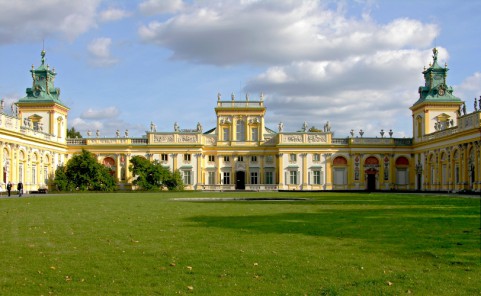History of the palace
The Wilanów Palace was established at the behest of King Jan III as his suburban summer residence. The building was designed by Agostino Vincenzo Locci (also known as Agostino Locci the Younger), an architect employed by the King during his 20-years’ reign. Initially, Wilanów was graced by only a small manor, reminiscent of residences of landlords rather than royal palaces. Essential extension works began as early as the 1680’s, and continued until the King’s demise in 1696.
During this period, the manor was refurnished into a representative palace reminiscent of French residences entre cour et jardin (lit. between courtyard and garden), with details drawn from Italian villa architecture. The shape of the Palace is clearly symmetrical, with the building divided into the northern part, with decorations dedicated to Queen Marie Casimire, and the southern part, “assigned” to King Jan III. The decorations on the façade by the courtyard, hailing the royal virtues as well as political and military achievements of the monarch, unambiguously evoke antique models. The figures of Famae at the centre of the façade, above the main entrance, proclaim the maxim Sociant cum pace triumphos (Triumphs bring forth peace). This maxim summarizes the personal philosophy of the monarch, who sought to ensure the welfare of the Commonwealth not only through military exploits, but also through peaceful rule, fostering the development of sciences, arts, and agriculture. The composition with sun and golden shields, adorned with a quote from the Book of Maccabees – Refulsit sol in clypeis (“The sun shone upon the shields”) – relates to the Janina coat of arms of the Sobieski family: a smooth shield, symbolizing care and safety as well as purity of virtue.
Decorations at the façade on the side of the garden refer to one of the most “arcane” works of antiquity, Virgil’s so-called Eclogue 4, and in some places remain puzzling to this day. Here, astrological symbolism, relating to the passing of time, was attached to the idea of introducing dynastic rule in the Commonwealth and of raising Jan III’s eldest son, Jakub Ludwik, to the Polish throne. The decorations also bear out the conviction that, after a period of unrest and conflict, the Commonwealth would enjoy the coming of the coveted golden age under the rule of the Sobieski family.
Though Jan III planned to raise a palace with wings to the sides, the monarch’s demise brought all extension works to a halt. They continued under Elżbieta Sieniawska, who bought Wilanów in 1720 from Konstanty Sobieski, the youngest son of Jan Sobieski. It was at her behest that wings were built to the sides of the palace in accordance with a design by Giovanni Spazzio, who alluded to the existing architecture and plans from the era of Jan III. The content of the exterior designs for the new parts of the palace focused on images drawn from Ovid’s Metamorphoses. At the turn of the 1730’s, the southern façade of the southern wing was rebuilt in accordance with a design by Johann Sigmund Deybel.
In the final quarter of the 18th century, Izabela Lubomirska commissioned Simon Gottlieb Zug to design three buildings for the immediate vicinity of the courtyard – Guardhouse and Kitchen, detached from the palace, and the Bath, attached to it. All three represent early Classicist architecture, both in the simplicity of their shapes, and in their decorations.
In mid-19th century, the northern façade of the northern wing was rebuilt in Neo-Renaissance style, with added decorations representing all owners of the Wilanów property, recalled in medallion portraits and familial coats of arms. In early 20th century, an additional floor was added to the existing building of the Bath.
suggested

Augustyn Wincenty Locci, the author of Wilanów Palace
François Paulin Dalerac, a French courtier of Jan III Sobieski and Maria Kazimiera, who resided in Poland for more than …















